The original URL of this article is:
www.africaspeaks.com/kenya/27082006b.html
My Second Week in Kenya
by Akilah Stewart
August 27, 2006
UWI Students Trip to Kenya
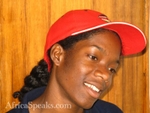 | | | Akilah Stewart | |
We had only been in Kenya a week but were informed by our host that our presence had begun to create quite a stir in the community. Just as they were eager to see us and to know more about us, we shared the same sentiments about them. It is so hard to gain an appreciation of a whole new world in a week, so to grasp as much as possible about the town and village we would discuss all our experiences and incidences in an effort to better understand the environment around us.
In addition to continually conversing about everything that happened in a given day, buying the Standard and the Nation, which are Kenyan daily papers, was an important part of starting the day. However, an understanding of the culture of Kenyans we met daily could not be appreciated from our brief one-time meetings or reading a newspaper. Often we were perhaps sidetracked by their politics which was quite a read, especially with the budget around the corner. We were actually in the middle of our stay when it was presented. In this second week, a feel of the local culture was better grasped as we left Bungoma for Kakamega where we would spend a great part of the next eleven days doing work in a village called Shikunga.
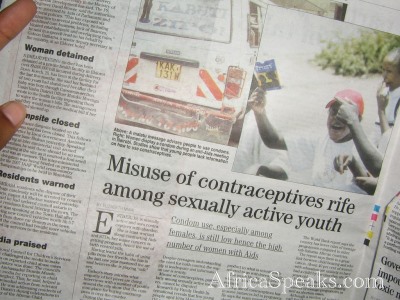 | | Shot of a article in a Kenyan newspaper |
Kenya is bordered by Uganda to the West. Bungoma Town is one of the last major stops before the border. Moving inwards through Kenya we passed another town called Mumias, then from there arrived in Kakamega Town. According to what I was told by Mr. Malaho, who was always helpful in explaining some detail on Kenyan life, culture or history, Mumia was a great king. He owned, from what I gathered, all the lands in the vicinity of the border up to Kakamega. If a local had committed a crime or needed to go to the king for business or some other purpose, they would have to travel and travel and would eventually stop at Kakamega to rest, then travel on to King Mumia in the place which was named after him, Mumias. With this reasoning, Kakamega means the 'Place of Rest'. And it proved to be most scenic and peaceful. In fact, the salutation on meeting someone there is 'mlembé' which means peaceful.
That Sunday, the 18th of June, was quite an eventful one. We packed our luggage which was sent directly to the St. Nicholas Stam Pastoral Centre in Kakamega but Mr. Malaho, a reverend at his church, had invited us to their Sunday Service. This, most of us attended and were privy to a small but deeply Christianized gathering. The men and male elders in the church sat in the front and the women and children took up the last four or five pews on the left half of the church. I can not recall why, but all of us were seated on the right half. Of course, as with everything we went to during our stay our delegates took an active part, this time in the service. Renee Alfred gave a beautiful rendition of a religious song and Kimberly Gay gave a sermon which was translated into Kiswahili for the gathering. I believe the Kenyans nodded more than we did in agreement with her selections from the bible.
This occasion turned out to be a very interesting one, for it set in motion my curiosity of what Kenya was like two, three, even five hundred years ago. I remember looking out a window that Sunday while listening to an elder sing a religious song in a grandioso, solid manner and seeing a corn field. These two things, religion; Christianity and corn; agricultural crop preference, struck me as two major things that were not indigenous to Kenya but were, at least to those we met, a fundamental and crucial part of their way of life.
On Monday, aside from adjusting to St. Nicholas Stam Guest House, we met with two Western University of Science and Technology lecturers – Mr. William Tolli and Ms Noelle Zilla who spoke with us about matters pertaining to Kenya and education, especially tertiary education. The student enrollment is the reverse of what it is at the University of the West Indies, St. Augustine Campus. While it is seven females to three males here, the ratio is actually the reverse there. There are six public or national universities, some specializing in a particular area or field, for example the Jomo Kenyatta University of Agriculture. Aside from these there are over a dozen private ones and in excess of fifty colleges. We were also supposed to visit the Kakamega Forest and a paper factory but time and the weather did not permit us to do so.
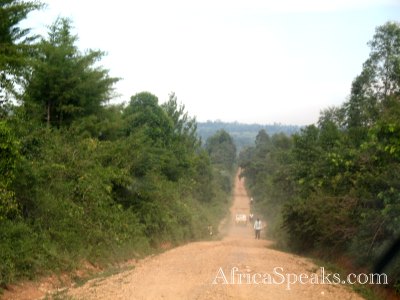 | | One of the smoother road to the KVDS headquaters |
On Tuesday we were taken to the Headquarters of the Kenya Development Volunteer Services (KVDS) located in Mr. Malaho's childhood village Shikunga for the first time. The drive there at times, if I were to complain, was flat out horrible by Trinidad standards. This brings to mind what Mr. Khatachi another host and KVDS member had once noted to me, that in many ways the poorer, simper folks such as those in this 'far off' corner of Kenya were being neglected by the government. These roads like many we drove on were paved. In the same breath it was pointed out to us that all citizens had to pay road tax. Of course, some roads such as those that led from Nairobi to Bungoma all the way to the Ugandan border, where laden trucks enter and leave the country, were smoothly paved. However rural roads where individual homes, stretches of crops, schools and shops were located were not paved. In many instances the probability of turning off from a pitched road unto another was low, as was the case in Shikunga. It was the type of soil that clumped together and created solid mud waves which became more defined after rain that made the drive on these roads very bumpy and that has made me wish to specifically highlight them.
Just before we arrived at the compound and were still seated in the matatus a group of between eight and twelve men appeared in front of us. In similar fashion to how a rhythm section here would operate with different persons playing a number of simple percussion instruments but with a catchy tempo, this group of middle aged men musically greeted us. Mr. Malaho remarked proudly that this welcome was on par to what the President would receive if he were to visit Shikunga. There was then a brief and informal introduction to some of the key men or executive members of the organisation. Following this all delegates actively took part in the preparation of seedlings and a Eucalyptus seed bed in the organisation's tree nursery. Later that day we also visited an abandoned Gold Mine.
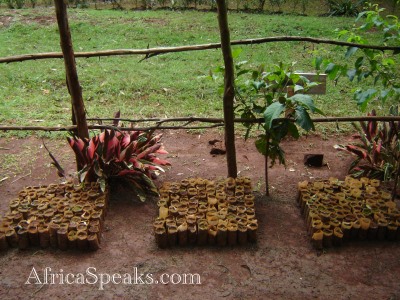 | | Some of our handiwork |
On Wednesday we went to Shikunga Village again and finished the preparation of seedlings which we subsequently stacked in groups of a hundred. Myself and a few others also made another seed bed for our selves. The set up on the compound was a heartening example of marrying modesty with efficiency. All the trimmings and fittings for the posts of the tree nursery as well as the sunlight buffer or roof for the young seedlings were directly obtained from the environment. All the structures e.g. the administrative building and the area where they receive visitors had mud walls. The sole source of water on the compound was a bore hole with a water pump. When we were there they were upgrading their toilet facilities. That is, instead of having a 'long drop' or latrine where you would stoop to floor level they cast over a seat made of cement with a central hole. My view of the place can be summarized by this entry into the journal I kept '…the hands that tend it are wise and the minds that perceived it endear it.' Indeed the KVDS was conceptualized a long and dedicated sixteen years ago in 1990.
We were given a small tour of neighbouring areas including a traditional blacksmith's workstation. The practice has remained unchanged for a number of generations. We were also taken to the river which is a principal source of water for many. Mr. Malaho described that one of the tasks of a new wife was to bring water to her husband's home and the homes of all his brothers and sisters. Therefore a young wife can make as much as five trips for water of an average distance of a half mile to a mile on not so flat ground. Other cultural practices were shared with us such as the grinding of millet, a traditional cereal crop (which has been now greatly replaced by corn). Most notably, the task of building a mud hut was first proposed to us on this day.
On Thursday everyone worked on the building of the mud hut and went visiting schools. The building of the hut involved first getting pillars for the frame, for this we felled Eucalyptus trees. I literally swung an axe into a tree and helped to bring it down. We brought down maybe a dozen or so trees, shaved them and hefted them to the site of the hut. We dug holes of a depth decided upon by our instructor and KVDS official Issac and placed our pillars that we cut to equal lengths into them.
Friday the delegation was divided into two groups, those who worked on the hut in the morning went to a school in the evening and the opposite occurred for those who left the KDVS Headquarters in the morning. I stayed and worked on the hut at the beginning of the day, and went to Shiakhondo Primary School in the afternoon. This was noted as the poorest of the schools we would visit. I could not discern the differences from this and previous schools, as noted from visits in the first week the infrastructure was not near the level I am familiar with in schools in Trinidad. What immediately struck me though was that the lighting for the students was slits deliberately built into the school architecture. The roof was raised and a space left for light to pour into the classroom. This was all the light that the students had the benefit of getting. The students were friendly, attentive and very polite and the small staff present had been very pleased to receive us. Steps are in progress to set a penpal sytem to communicate between students from Kenya and Trinidad and Tobago. While on this visit the other members danced mud to make handmade wet bricks that would dry after being packed onto the frame we had began preparing the day before.
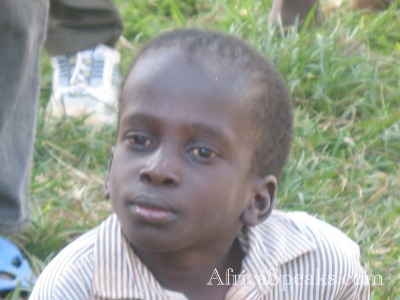 | | An orphan and one of the most memorable faces of my experience in Kenya |
Similarly, on Saturday the team was split into two and again my half partook in the hut building exercise in the morning while the other part of the team went to Mwundushi Self Help Group. Before this however, a few members of the delegation were taken to cut, collect and tie bundles of grass for the roof of the hut. It was a long process and the entire matatu was packed in every available spot with bundles of hay we had heaved from the field. Later we went to Furaha Women's Group, a Seventh Day's Adventist group and the Ematutu Children's Orphanage. The Women's group help with the running of the orphanage. It was good to see that it was fairly well funded. They have mosquito nets and are getting a new building which among other things will house computers. Just as with all the schools and the other self help groups before, these performed for us. When I assumed they were singing a song to us in Swahili or some dialect we had been exposed to before, I was informed that they were actually singing a traditional Congolese song. Everytime we got a little accustomed to something such as a Ugandan fertility dance that was perofrmed for us more than once, some new detail was introduced, each time emphasizing how complex and diverse the cultural dimensions of the places we visited were. The majority of the hut was completed on that Saturday.
UWI Students Trip to Kenya in pictures:
http://rastafarispeaks.com/gallery/Trip_to_Africa_2006
|
|